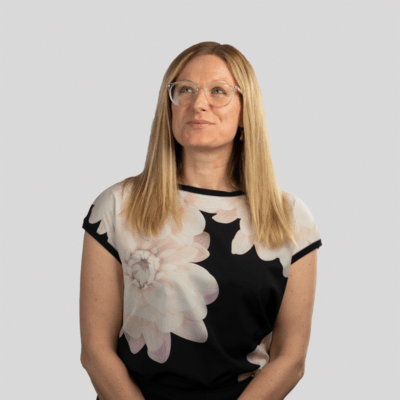Posted on: 7th July 2016 by Private: Helen Forrest
The BLOODHOUND Project is a global Engineering Adventure, using a 1000 mph World Land Speed Record attempt to inspire the next generation about science, technology, engineering and mathematics.
Earlier this week the BLOODHOUND team announced that, thanks to a new sponsorship deal, BLOODHOUND SSC will aim to break the land speed record in October 2017. The record attempt will try to reach 800mph (the current World Land Speed Record stands at 763.035mph or 1,227.99 km/h). Following this, the 1000mph attempt will take place in 2018.
Did you know that aluminium plays a key part in this exciting and ground-breaking project? Innoval is very proud to be part of it. Read on to find out how we’re involved.
Some facts about BLOODHOUND SSC

The BLOODHOUND Project has designed and built BLOODHOUND SSC, a supersonic car. This car will not only go faster than the speed of sound; it will reach a speed of over 1,000mph (1,600km/h). Incredibly, BLOODHOUND SSC will cover a mile in just 3.6 seconds and the equivalent of 4.5 football pitches in just 1 second!
BLOODHOUND SSC is roughly 13.4m long and weighs 7.5 tonnes. Its design uses a mix of car and aircraft technology, with the front section being a carbon fibre monocoque and the back portion being a metallic framework and panels. The two front wheels sit within the body and two rear wheels are mounted externally within wheel fairings.
Both a jet engine and a rocket will power the car. Together they will produce more than 135,000 horsepower, which is more than six times the power of all the Formula 1 cars on a starting grid put together.
BLOODHOUND SSC is the most complex car ever built. Over 3,500 parts (and 22,500 rivets) make up the car, many of which have been designed and manufactured specially for the project. Over 110 man years of effort have been invested in the design, build and manufacture of BLOODHOUND SSC.
Why are we involved?
Everyone at Innoval is passionate about inspiring the next generation of scientists and engineers. We also believe the BLOODHOUND Project provides a powerful means of showcasing the technical capabilities of aluminium. Aluminium is the material of choice for a host of parts from the car’s wheels to large sections of its chassis and subassemblies.
For these reasons, we’re a BLOODHOUND Product Sponsor which means we’ve helped with the design and build of the car.
How are we involved?
Initially we helped the team at Lockheed Martin, who conducted the initial feasibility study, to decide which alloy to use. The initial alloy choices were AA2014 and AA7075 as these are the aluminium alloys used for aircraft wheels. They have also been used for earlier generations of land speed vehicles.
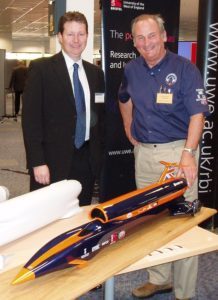
The two initially chosen alloys were assessed for impact resistance by firing particles of material from the run site (Hakskeen Pan, South Africa) at very high speeds at samples of the two alloys. We looked at the nature of the damage caused by impact of the high speed particles.
The ‘gas-gun’ trials were undertaken at the Cavendish Laboratory (Cambridge) under the watchful eyes of the Lockheed Martin team. The trials investigated the damage introduced by the impact of rock particles at approximately 1000 mph.
The team conducted ten experiments, five on each aluminium alloy. There was no sub-surface damage in any of the recovered samples. This suggests that both aluminium alloys responded to impact by plastic flow only. However, to be conclusive a more detailed metallographic analysis was necessary. Therefore, we took several of the worst-affected samples back to Innoval’s test labs for further analysis.
Optical Metallography
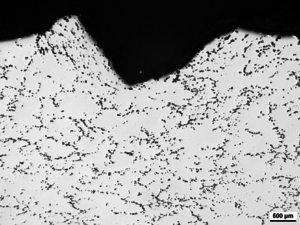
We wanted to determine if any microstructural differences between the two materials could be observed after impact, and whether this could be used to rank the materials.
We used optical metallography to examine the projectile impact area to look for evidence of micro-cracking. We conducted Vickers microhardness (Hv) measurements to assess the extent of deformation hardening in the impact area.
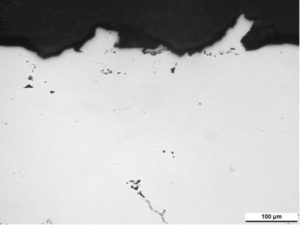
In the region of projectile impact, there was some tearing of the aluminium surface, but we found no significant cracks. The subsurface region was hardened by around 5-10% to a depth of about 1mm below the impact crater.
There were no significant differences between the behaviour of the two aluminium materials (AA7075-T651 and AA2014A-T651). As a result, the stronger AA7075 alloy was selected.
A stronger alloy
Following the impact trials the BLOODHOUND design team asked us if stronger aluminium alloys were available. We carried out a search and found that both Alcoa and Otto Fuchs had developed stronger aluminium alloys for large aircraft forgings. Both of these alloys were developments from the alloys AA7010 and AA7050. These, in turn, were developments from the original AA7075 alloy composition. The new alloys had the registered designations of AA7085 (Alcoa) and AA7037 (Otto Fuchs).
The final choice
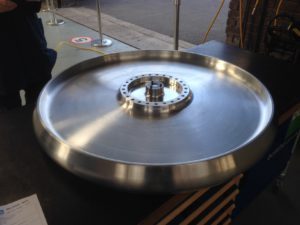
Both alloys had similar properties and were eminently suitable to make the forgings for the BLOODHOUND wheels. However, because the AA7085 alloy was not available in Europe, the AA7037 alloy became the obvious choice. Furthermore, Otto Fuchs could produce the large diameter forgings suitable for wheel manufacture (watch a video of the wheels being forged – it’s amazing! Can you spot our logo?).
AA7037 was therefore the alloy of choice for production of the desert wheels. The wheels for the runway trials were made from the AA7075 alloy as these could be machined from blocks and did not have such a high strength requirement.
What’s next for us?
Our Materials Testing department will carry out a detailed analysis of the forged and machined AA7037 alloy wheels after the first desert runs in 2017. However, Innoval’s involvement with BLOODHOUND doesn’t stop there. Rachel Wiffen, one of our Process Engineers, is a BLOODHOUND Aluminium Ambassador.

